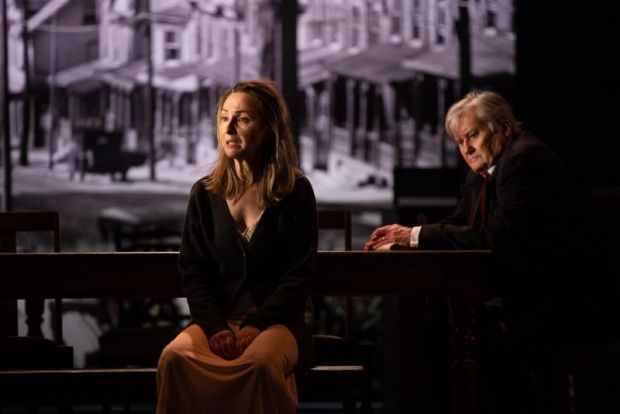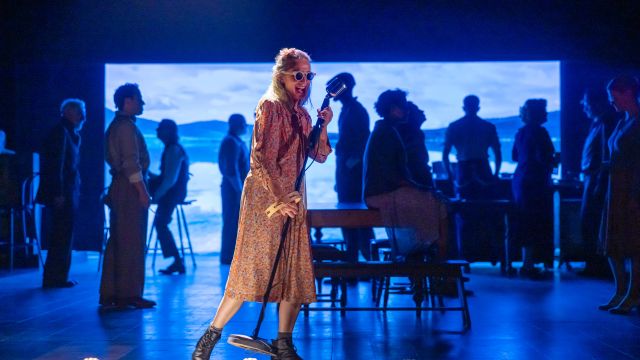Girl From The North Country
Bob Dylan says of his Minnesota heritage: “I was born in Duluth – industrial town, shipyards, ore docks, grain elevators, mainline train yards, switching yards. It’s on the banks of Lake Superior, built on granite rock. Lot of fog horns, sailors, loggers, storms, blizzards.” Overlaid with a 1930’s wintry patina, this is the bleak, down-at-heel setting chosen by Irish writer/director Conor McPherson for Girl From The North Country.
In 2013 Dylan’s manager approached McPherson to gauge his interest in creating a theatre show featuring Dylan’s music. After initial hesitation, then rigorously sifting through some forty albums, the playwright grasped the challenge and this melancholic work was born. There are also some interesting tales to be found telling of how McPherson chose the range of songs for this production. Bob Dylan won the 2016 Nobel Prize for Literature "for having created new poetic expressions within the great American song tradition." McPherson has lifted inspiration from an era, the music and lyrics and has crafted a story that sits outside Dylan’s personal 60s and 70s timeline. He also interprets some of the songs, a mix of obscure and classic tunes, in a refreshingly non-Dylan manner.
The setting may reflect 1934’s depression-era desolation but the supremely talented cast inject the work with energy and spirit. As impressive as their acting and vocals are, it is their connection to character and narrative that seals the deal. Amidst complex family dynamics, mystery and illness, various characters inhabit or pass through a sometime Duluth guest house on the verge of foreclosure. The assortment of characters is rich and the collision of their life stories certainly overtakes believability, but that doesn’t detract from the impact. Every actor and their individual voicing of the Dylan songs imbues the musical moments with sensitivity as songs flow between textual elements then return us to the story. Not every song is exactly linked to the theme they might bookend, but there is enough connection, and it is certainly enough to sit back and absorb the beauty of every musical fragment.

While all the cast are excellent, stellar Australian actor/singers to mention are Helen Dallimore, Lisa McCune and Christina O’Neil who dazzle at every turn, both dramatically and musically. Adelaide’s own Elizabeth Hay and James Smith also shine, as does Tony Cogin. NIDA graduate Chemon Theys and an imposing Elijah Williams were also outstanding as Marianne and Joe, their gradual drawing together as a couple a ray of hope midst tragedy. Blake Erickson (harmonica-playing Elias) has one bright moment to showcase his remarkable and powerful sound and range in Duquesne Whistle as his tortured character finally steps into the (heavenly and literal) spotlight.
Rae Smith’s appropriate set, props and beautiful photographic but slightly jarring backdrops fly in and out or are manipulated by the cast, often in dim light. I had the impression of peering through a window to view a dollhouse-like construction where miniatures and characters are shifted by the hands of fate and circumstance. Stepping up to a vintage microphone outside the action at times, Dr Walker (Terence Crawford) channels a droll Garrison Keillor tone and cadence as he ponders the narrative from beyond the grave. As scenes shift and songs interweave with the text, shadow and silhouette play a part in the mood. These tableaux augment the feeling of heightened realism as do subtle but stylized choreographic additions.

I am definitely a fan of atmospheric lighting, particularly side-lighting, but now and then Mark Henderson’s illumination lost me, or perhaps the cast failed to find their light and were left with deep shadows on their faces. Musical Director Andrew Ross and excellent onstage band The Guilty Undertakers contribute meaningfully to the action as they wander through playing or linger at the side of the set as quirky personas within the frame. Additionally, Greg Stone and Helen Dallimore learnt to drum for this show and ably take turns at the kit while others in the ensemble use tambourines or shakers to bump up the sound.
Conor McPherson describes Girl as “a play featuring Bob Dylan’s music” but this IS a musical offering with dramatic storylines, and the opening night audience definitely entered into the marvellous whimsy. The poetic nature of Dylan’s lyrics lend themselves well to on stage drama and philosophical, almost spiritual musings. There is a sense of parable to the stories unfolding on stage which suits the uncertainty and struggle of trying to survive 1930s America.
This is a tight, professional and welcome production and a joy to behold. With a large ensemble taking to the stage and nailing every element of the layered production, it is totally worth a visit.
Lisa Lanzi
Photographer: Daniel Boud
Subscribe to our E-Newsletter, buy our latest print edition or find a Performing Arts book at Book Nook.

